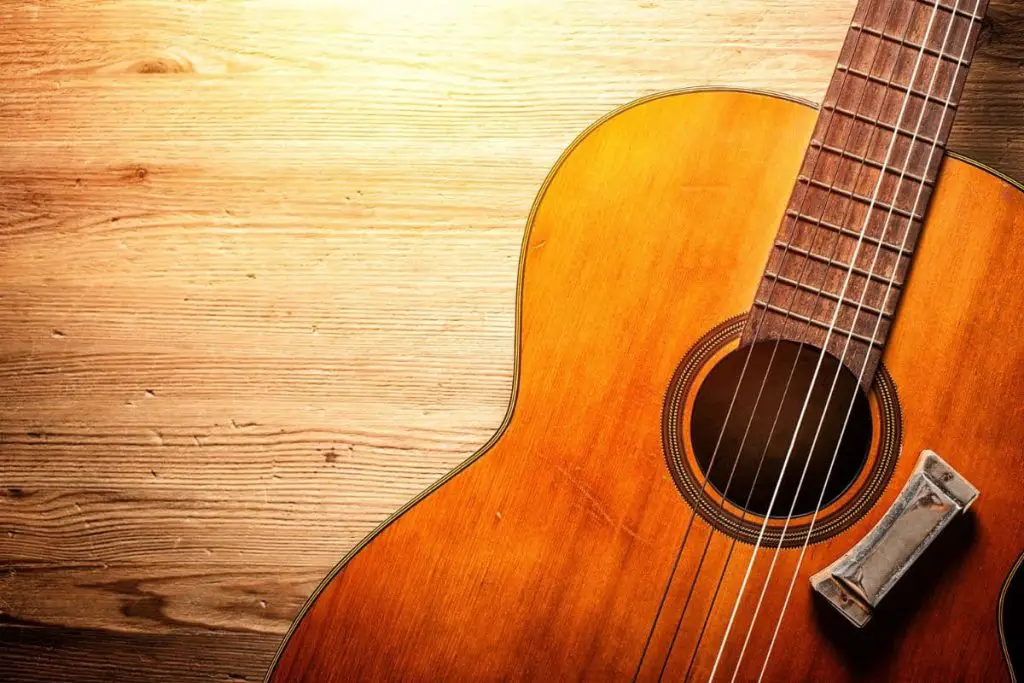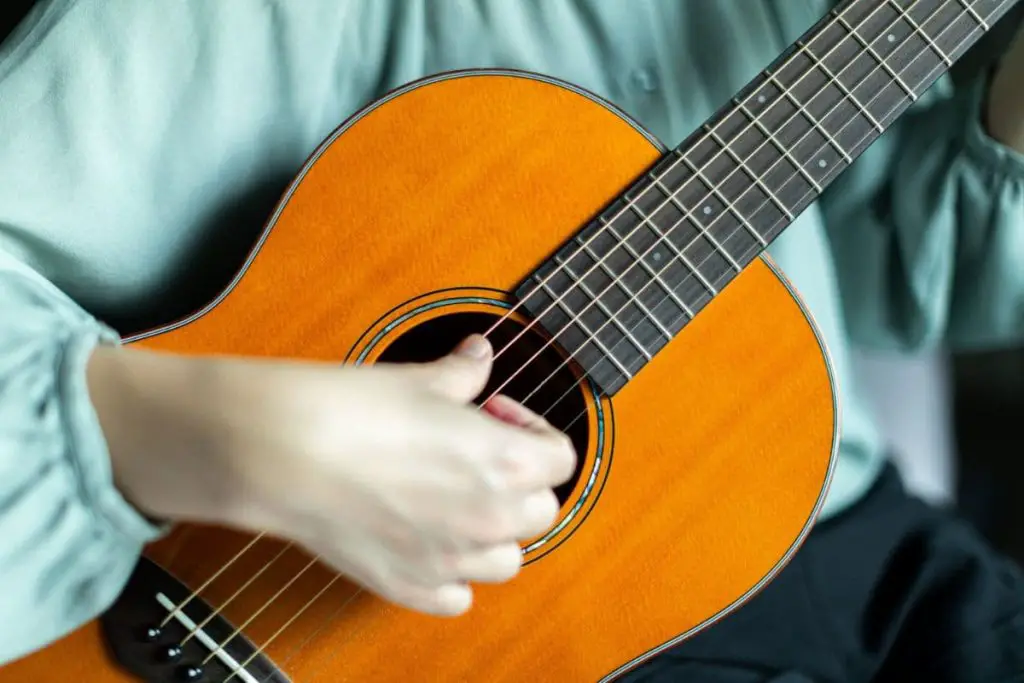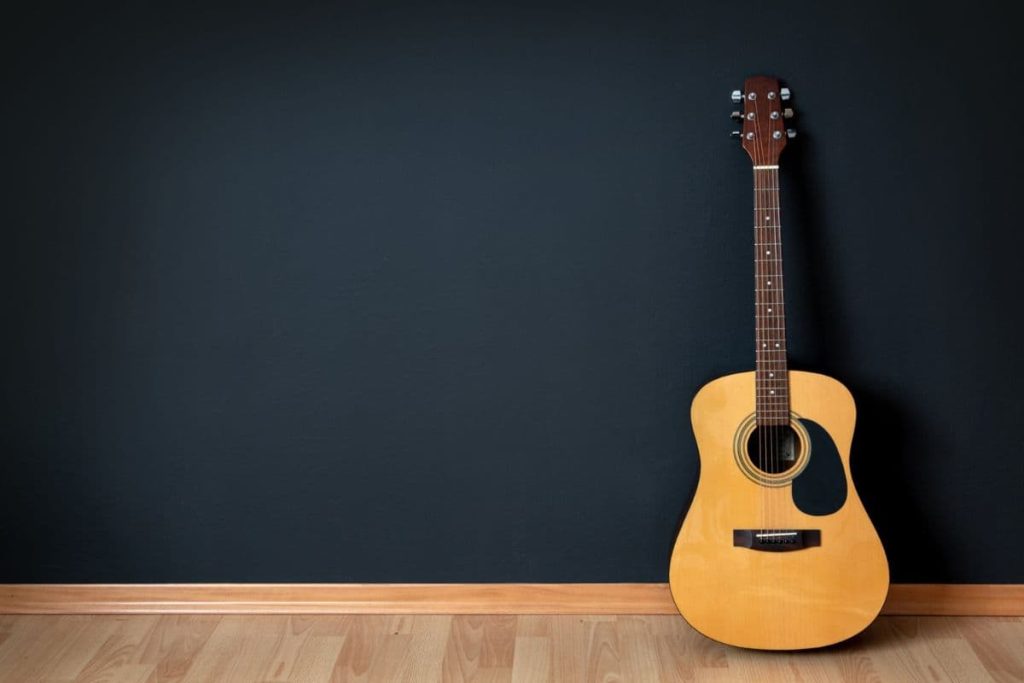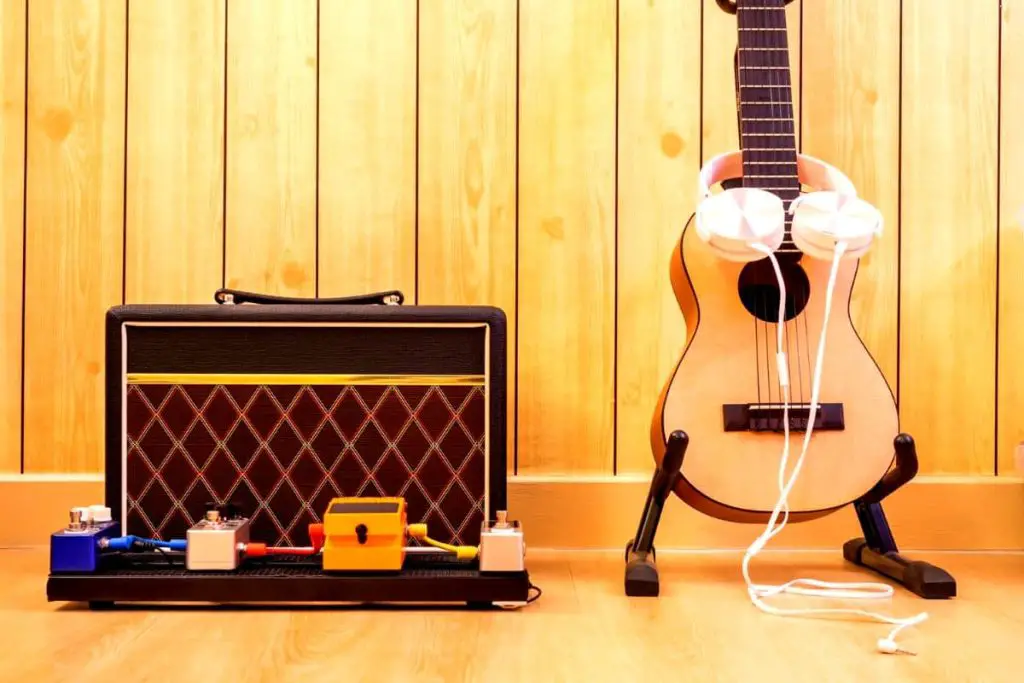Playing the guitar is not as easy as it seems, especially if you don’t have much experience with other instruments. As a beginner, you may feel like your guitar playing hasn’t improved, even though you have been practicing a lot. However, you shouldn’t give up as there are several reasons why your guitar playing may not be at the level you expect.
The most common reason your guitar playing sounds bad is that it is out of tune. Most of the reasons your guitar playing sounds bad are about the physical condition of your guitar. For example, it could be because your guitar has bad intonation, poor string quality, or old strings.
The following sections of this article highlight issues contributing to your guitar playing sounding off. Read on to determine the problems affecting your guitar playing, and use it to make appropriate changes. You’ll notice an improvement in sound in no time!
👇😀👇NOTE👇😀👇
If you want to find out what my recommended guitar gear is, then here is what I recommend on Amazon:
- Fender Cutaway Acoustic-Electric Guitar Bundle (MY FAVORITE GUITAR)
- Snark SN-8 Super Tight All Instrument Tuner (Easiest Tuner I’ve Used😏)
- 6 String Acoustic Guitar Capo (Best CAPO for quick changes)
- Dunlop Max Grip 1.0mm Nylon Picks (Thick Guitar Pick So You Don’t Lose Grip!)
- Universal Guitar Stand (Cheap & Minimalist Guitar Stand I Recommend)
- Levy’s 2″ Wide Quick Adjust Guitar Strap (Best Guitar Strap For Any Level)

1. Out of Tune
When you realize your guitar playing sounds bad, the guitar’s tuning is the first factor you should consider. Even a single guitar string a bit out of tune can significantly contribute to your guitar producing unpleasant or unexpected sounds. If the guitar is out of tune, you can use an electronic guitar tuner to ensure the guitar’s strings are in tune.
There are three types of electronic guitar tuners:
- Vibration-based
- Microphone-based
- Plug-in or pedal based
Alternatively, there are numerous free and subscription-based smartphone applications for tuning guitars for those who cannot afford to buy a tuner.
However, if you own a cheap guitar, you will have to tune it more often since they tend to go out of tune faster because they consist of lower-quality components.
2. String Slippage
Sometimes, your guitar playing will sound bad not because some guitar strings are out of tune but because of string slippage. String slippage is when some guitar strings slip out of tune while you play. You should inspect the guitar’s string trees, machine heads, or bridge if you suspect string slippage.
Guitar strings can get caught in the string trees and gradually slip and fall out of tune, especially as you play. You can rectify the problem by tuning the guitar and lubricating the string trees or buying better-quality string trees.
However, if the string slippage results from issues in the machine heads or bridge, it is advisable to buy a new guitar since it is challenging to fix tuning problems arising from such components.
3. String Type
The type of string you choose to put on your guitar can also influence the sound it produces. The primary string factors that can make guitars sound bad are their quality and application. Low-quality strings consist of cheaply-sourced components and do not contain any properties meant to enhance their sounds. Hence, they tend to fall out of tune easily and generate poor sounds.
Therefore, it would be best to buy a new higher-quality set of guitar strings to resolve sound quality issues. On the other hand, some guitar strings sound best when played to a particular style of music. For instance, a guitarist can use certain strings to play folk, classical, rock, and pop music, while other strings can only generate sounds geared toward a specific music genre.
Thus, it is advisable to use the appropriate type of strings whenever you play to avoid disappointing playing sessions.
4. Old Strings
The age of your guitar strings also significantly affects sound quality while playing. If you are a frequent player, your guitar strings will gradually age with every finger stroke, and in some instances, the strings might snap.
The result is a dull-looking and off-sounding guitar that can discourage you from playing. However, you can easily correct the issue by purchasing a new set of guitar strings and make sure you tune and stretch them before you begin playing (Question: Why does the g string go out of tune?).
Once the brand new strings are in place, you will notice that they will produce a more vibrant tone and be more responsive to your finger strokes, resulting in higher quality music production.

5. Dirty Strings
Most amateur guitar players do not know that their guitar strings can get dirty. Thus, they usually neglect cleaning them. As a result, oil and sweat from the players’ hands contribute to the buildup of gunk within the guitar strings.
In addition, depending on the storage methods used, a guitar can also be exposed to dust. Gradual dirt accumulation on the guitar strings may alter their tone and sound quality. You can correct the issue by ensuring you regularly clean your guitar, preferably after every playing session.
You should also invest in a guitar storage case or cabinet to prevent leaving the guitar exposed to elements that will influence the tone of the strings. I recommend the CAHAYA Acoustic Guitar Case (available on Amazon.com). The case is waterproof and has thick padding protecting your guitar against dirt, moisture, and extreme weather elements.
6. String Height
String height refers to the distance between the guitar strings and the fretboard. In instances where the strings are too close to the fretboard, the strings tend to vibrate against the fretboard when you play, resulting in a rattling sound or unusual vibrations.
Factors that can cause your guitar’s string height to change include fluctuations in temperature and humidity. To test the string height on your guitar, hold each string at the third fret and ensure the string does not touch the first fret.
If they are too low, you should adjust the string height. There are three major methods for changing string height for an acoustic guitar:
- Adjusting the height of the bridge saddle.
- Adjusting the height of the nut.
- Adjusting the truss rod.
7. Applying Little Pressure
Another common reason why your guitar playing sounds bad is applying bad technique For instance, the pressure applied during play is vital to achieving your desired sounds, especially when playing barre chords.
Suppose you apply insufficient pressure on the strings when you play. The chords will not produce muzzled sounds. Moreover, it will cause the strings to vibrate and rattle against the frets, making a buzz that interferes with other tones.
However, it is easy to correct your playing technique with practice. Pick a string on the guitar and place your finger on it. If one or more strings produce a buzz, apply more pressure on the string.
8. Applying Excess Pressure
On the other hand, the issue with your playing technique might be applying excess pressure on the guitar strings. When you apply too much pressure, some sounds will come off as too sharp to the ear or out of tune.
Excess pressure can also mute the sounds produced, resulting in compositions that sound like the guitarist skipped notes while playing. Therefore, you should relieve the stress you apply on your guitar if it makes muted sounds and ensures your other fingers do not touch the other strings.
The amount of pressure applied on the guitar strings is a balancing act because too much or little pressure can discourage a guitarist from playing or learning due to poor sound.
9. Strumming Technique
Strumming refers to stroking the guitar strings using either your fingers or a guitar pick. Like applying the appropriate amount of pressure on guitar strings along the fretboard, measuring the amount of force applied during strumming is crucial.

Excess force can twist the guitar strings and force them out of tune, resulting in a bad sound. Therefore, it is advisable to strum your guitar as lightly as possible to achieve the kind of sound you desire.
10. Guitar Quality
Like most physical materials, the price you pay for your guitar considerably influences the quality of the product you will get. Cheap guitars often consist of low-standard materials in addition to being mass produced. Thus, they are less likely to make quality sounds.
You must not compromise on quality to save a few dollars when purchasing your guitar. Costlier guitars are often handcrafted, meaning the producers take time to ensure they will produce the correct sounds when played.
However, that does not mean you cannot look for deals on guitars. Even quality guitars can be found at affordable prices, so don’t feel discouraged if you cannot splurge on a high-end guitar at the moment.
11. Playing Space
The environment when you play the guitar can also contribute to poor sound. That is because sound bounces off or reflects off materials with which it comes into contact. Moreover, the size of the playing space can also affect sound reflections.
For example, if you play in a small room with flat reflective objects, the sound will likely bounce around the room, producing low-end frequencies. Thus, you should consider playing in a larger room or at the center of your current playing space to minimize sound reflections.
Alternatively, you can modify the room’s sound elements through acoustic treatment.
12. Storage Methods
The conditions under which you store your guitar can hugely impact the sound quality when you play because guitars primarily consist of wood, which reacts to changes in climatic conditions. For instance, guitar wood often swells in humid or damp conditions, resulting in the generation of muffled sound.
On the other hand, the wood dries out when exposed to high temperatures. Therefore, it is crucial to monitor your guitar’s storage conditions. The temperature should be between 65 and 80 degrees Fahrenheit (18.33-26.67 degrees Celsius), while the humidity should be between 40 and 55 percent. If you live in a very humid area, consider buying a humidifier to help you control humidity in the storage room.
I recommend the O Oasis Humidifier (available on Amazon.com) for people who own acoustic guitars. The humidifier has soundholes for optimal humidification. It is also cheap, making it affordable for almost every guitar owner.

13. Poor Intonation
Intonation refers to the similarities and differences in notes produced on the fretboard when playing the guitar. It is one of the properties many guitarists, especially beginners, tend to ignore. However, poor intonation can result in unpleasant sounds, especially when playing barre chords.
When your guitar has bad intonation, some barre chords will sound in-tune while others at different positions on the fretboard will sound out of tune. Correcting poor intonation requires tuning the guitar, sounding the string on the twelfth fret, and adjusting the bridge saddles until the twelfth fret is in tune.
The process can be challenging for most guitar players. Hence, it is advisable to take your guitar to a technician for proper fixing.
14. Truss Rod Adjustment
The truss rod is a component found in acoustic guitars that runs along the length of the guitar neck. A truss rod helps offset the pressure steel strings exert on the guitar’s neck. Its adjustability helps determine the amount of pressure on a guitar’s neck. Therefore, when the truss rod is loose, it can cause your guitar to produce unwanted sounds and vibrations.
You should open the truss rod cover and confirm if it is loose. If so, use a wrench to tighten it. Lastly, when you finish adjusting the truss rod, ensure you also secure the cover in place tightly to avoid it rattling while playing, which will produce vibrations that will interfere with your play.
15. Bridge Adjustment
Adjusting the truss rod can cause other guitar parts like the bridge to be realigned. The bridge holds guitar strings in place on the guitar body and helps determine the strings’ action height. Failure to adjust the bridge after truss rod adjustment can also cause the guitar to make undesired sounds.
The adjustment process depends on the type of guitar and bridge. For instance, fine-tuning the bridge on a classical guitar is harder since the bridge uses a knot system to hold the strings in place. On the other hand, in acoustic guitars, bridge adjustment involves turning the bridge pins towards or away from the headstock.
16. Issues with Recording
Some people learn to play the guitar to produce and commercially release their works. However, paying for studio time can be costly. Thus, they often set up a digital audio workstation in their homes. Some will proceed to use an adapter to plug their guitars into their laptops.
Unfortunately, recording your guitar using a laptop will not generate the same sound when plugged into an amplifier. Therefore, you need to invest in a decent adapter and install amplifier simulators to ensure your laptop correctly captures your guitar sounds.
Alternatively, you should consider purchasing an amplifier or pedal with USB recording features and ensure you adjust the settings to meet your needs. For guitarists planning commercial production, I recommend the EMB Pro 700-watt (available on Amazon.com) digital amplifier. This remote-controlled amplifier has two input ports and bass functions, supporting quality production.
17. Pedal and/or Amplifier Settings and Quality
For people who play electric guitars, the amplifier significantly impacts the type of sound produced. If your amplifier generates a poor sound, it could either be the quality of the amplifier or the adjustment settings.
Therefore, if you buy a cheap amplifier, expect it to produce poor sounds. Hence, you should consider which type of amplifier you’ll use before purchasing it.
If you own a decent amplifier, you should take a look at its settings. Amplifiers have several knobs that control factors like the treble and bass that influence the quality of the sound produced. The adjustments can be challenging for beginners. However, experimenting with different settings will help you identify a specific setting that suits you. Additionally, remember to adjust pedal settings because they also influence the sound.

18. Guitar Pickups
A pickup is a component found in electric guitars that detects vibrations from guitar strings and converts them into electric signals an amplifier can use to produce sound. Different types of guitar pickups have different kinds of sounds. For example, a single-coil pickup will produce thin sounds instead of humbucker pickups.
Therefore, ensure you know what kind of tones you want your guitar to produce when selecting pickups. Moreover, quality guitar pickups often found in cheap guitars can result in unbearable sounds because they cannot correctly detect vibrations when you play.
Alternatively, the pickup could have a design flaw contributing to poor sounds, like a wrongly wrapped coil, hence the need to regularly take your guitar for maintenance.
19. Warped Fretboard
The fretboard needs to be straight for your guitar to produce desired sounds. However, when the fretboard bends out of shape, it will sound badly when you play. That is because a bent fretboard affects the guitar’s action. When the action is too high, players will have difficulty pressing down strings to produce chords resulting in softer than expected sounds.
Conversely, if the action is low, the strings will bounce off the frets during play, producing vibrations that distort the entire composition. The materials used to make a guitar are the most significant contributor to fretboard warping since cheap materials get warped easily either during shipping or depending on their storage conditions.
Fixing warped fretboards is difficult. Hence, it is advisable to buy a new guitar if your fretboard has such problems.
20. Properties of the Top Wood
The wood used to make a guitar considerably influences the sound it produces, with the top wood having the most influence over the sound. The best woods for making guitars include:
- Maple
- Mahogany
- Cedar
- Spruce
However, cheaper guitars use other woods that sound bad when played. Moreover, the thickness of the top wood also influences the sound. A thick top wood absorbs sounds resulting in low volume sound, while thinner top woods found in high-quality and expensive guitars produce better sounds.
Overall, if your guitar has poor quality or thick top wood, the best way to resolve the issues is to buy a better guitar since you cannot replace the top wood.
👇😀👇NOTE👇😀👇
If you want to find out what my recommended guitar gear is, then here is what I recommend on Amazon:
- Fender Cutaway Acoustic-Electric Guitar Bundle (MY FAVORITE GUITAR)
- Snark SN-8 Super Tight All Instrument Tuner (Easiest Tuner I’ve Used😏)
- 6 String Acoustic Guitar Capo (Best CAPO for quick changes)
- Dunlop Max Grip 1.0mm Nylon Picks (Thick Guitar Pick So You Don’t Lose Grip!)
- Universal Guitar Stand (Cheap & Minimalist Guitar Stand I Recommend)
- Levy’s 2″ Wide Quick Adjust Guitar Strap (Best Guitar Strap For Any Level)
Related Posts:

